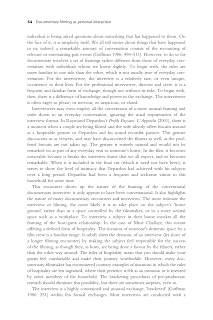Critical Reflection
We could do with more actuality/sequence of interview footage. We found with interviews today as soon as the camera starts rolling it felt a bit forced and unnatural.
We also discovered that the sun going in and out changed the exposure, somewhat dramatically sometimes.
Next time we need to capture uncultivated plots as well as the opening shot, more interactive GVs (plot actuality) we would also like to try and do a OTS track shot, but this may prove difficult without a stabliser (Track/dolly)
Contextual Research
The Components of an Interview
Interviews are usually best shot in the following compositions:
Medium Shot (MS): From the waist to the head.
Medium Close-Up (MCU): From the center of the chest to the head.
Close-Up (CU): Only the head and face
A Note on Wide Shots (WS): A wide shot emphasizes the space instead of the subject. In many cases, the subject’s whole body is included in the frame. Wide shots are generally not appropriate for interviews because we cannot easily see the Interviewee’s expression. There are, however, times where a wide shot is appropriate for an interview. When there is something of special importance in the background, and it cannot be framed in a closer shot, then it is appropriate to use a wide shot for the interview.
In addition to the interview itself, it is important to get other shots:
B-Roll: Are images that the editor will cut together over the Interviewee’s voice. Usually they relate to the subject being discussed by the Interviewee. For example, if the Interviewee is discussing the architecture of the Potala, then you would want to get some shots of the entire building, as well as close-ups that illustrate the finer details.
Cutaways: These are usually Close-Up shots recorded with a second camera (if one is available). Cutaways isolate details about the Interviewee, such as hand movements or facial expressions. The purpose for taking cutaways is to give the editor more choices.
If you are shooting more than one interview, try to alternate where you place Interviewee in the frame, from left to right.
In this short documentary we meet Louis Ortiz, an unemployed man from the Bronx whose life is turned upside down when he discovers his uncanny resemblance to President Obama.
DAVID LYNCH INTERVIEW PROJECT DEACON HADLEY from interview project on Vimeo.




Good research here - actuality interviews are even more challenging as you have the continuity challenges to compound the editing process. Another useful shot is the 'non-sync wide' which is a de-focussed wide shot (usually with interesting foreground) which you then have the luxury of using anywhere within the interview to cover edits as the people talking are out of focus. These can be shot afterwards. Equally interview responses can then inspire sequences which you can shoot which then provide interesting illustrations of what is being discussed and of course cover your edits.
ReplyDelete